While getting our four legged family members their rabies shots at our long time veterinarians (it’s the law so we go), I saw some pet first aid kits so that sparked a few questions. Most notably, about going beyond the basic first aid kit when prepping for survival.
What about if SHTF and a pet owner couldn’t make it in to any vets? What are some ways the basic pet owner could be more prepared?
Of course, this is in theory and a pet owner is not a veterinarian. He didn’t want to advise much, and please note, this is in no way medical advice or direction to take the place of a trained professional.
I am probably better off than most pet owners, as I have had vet tech training and had animals all of my life. BUT it was agreed all around; the basic person would be ill-prepared for extreme emergencies with their pets.
This article is to help you prepare yourself with knowledge to care for the most common emergency treatments for your pets. Most SHTF medical situations with animals will be swiftly onset, with no warning, and a fatal outcome has a chance to be avoided if care is given in a proper manner.
Actually, as we live so far from our vet, and many things can result in shock or death within minutes, this is what we stress to anyone we know who is a pet parent.
We work with a few pet-oriented organizations, including a Pets for Vets non-profit, and we have many of these in courses for just this reason. If there is no doctor within distance, you need to know some basic emergency treatments. Just like you would for any child. It can save your furry loved one’s life.
A little training can make a world of difference for a pet, including diminishing pain from an injury, or suffering lifelong effects from a medical emergency resulting in damage to their organs, or even going into shock.
The overview of treatments below is a good way to prepare yourself now, for future emergencies with your pet. We plan to have an article on each treatment, its signs and different treatments in survival situations.
You should know how to take vital signs for each pet you own, and how to give CPR to each of your pets. Pets are built differently, so arming yourself with the knowledge of HOW to perform CPR on your pets can save their lives.
Kits you should have ready:
A Pet First Aid kit including items for your specific pets
A Pet BOB individualized for your pets
If not for the long-term haul with items meant to last and make a life for your pet elsewhere for a while, at least have a 72 hour supply BOB with emergency foods and supplies for each pet packed.
The hedgehog may not have the same sized BOB as your dog or potbellied pig, but he will have a lot of the same basic needs to be met. Although, his food, clothing (warmth), and bedding needs can differ greatly on how they are met.
Emergency Shock Kit
Below, I go into great detail about shock. As any extreme conditions, stress, injury or ingested matter can result in it and once the body goes in shock, it is oft time fatal.
Here is my emergency kit for shock. You will want some instant sugar like honey to get glucose to the liver so it can function properly. We use the prepackaged honey condiments.
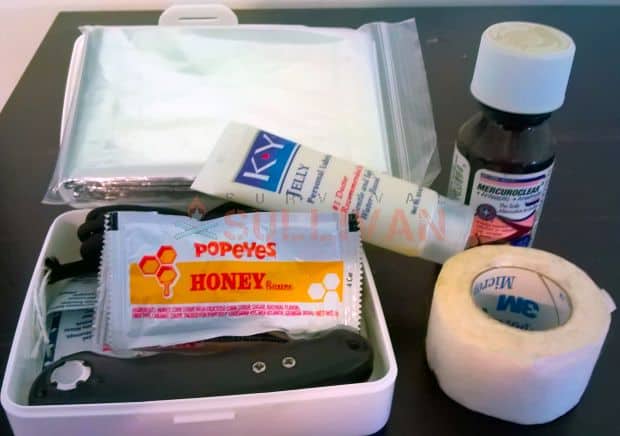
Medical practices for your pet’s survival
Know how to quiet and comfort your pet during and after a seizure
Seizures can happen suddenly, or small signs like shaking and unsteadiness may preempt them.
There is not much you can do during the seizure, except hold your pet and gently restrain him until it passes. Keep him from sharp or hard edges and objects, and talk soothingly to them.
You can wrap them in a towel, blanket, or jacket to help quiet them and hold them from flailing. Weathering the storm is about all you can do. With older dogs you can try to provide a quiet and calm environment to avoid future episodes.
If a bad seizure is happening, you may want to put a towel edge or Popsicle stick across the tongue to keep them from choking or biting down on their tongue.
Know the first signs of your pet going into shock and how to prevent it
As if any of the other conditions progress, the dog can go into shock so it’s very important to know its signs. Many things can throw your pet into shock. The main signs to look for are:
- Eyes look “black” as the pupil has gotten so big
- Gums are “white” and light colored
- Your pet feels cold- paw pads, ear tips, nose
- The pet may or may not be drooling and seem dazed
Ears:
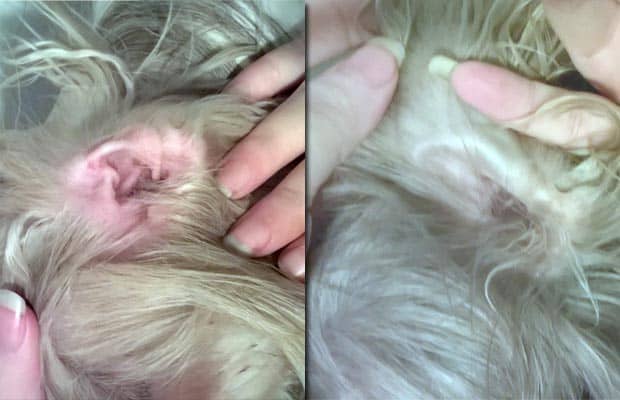
Gums:
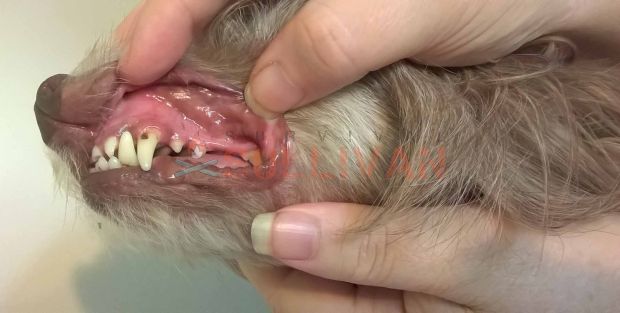
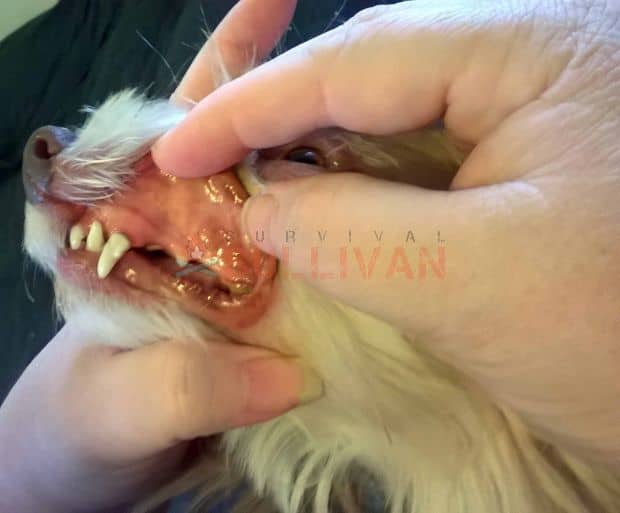
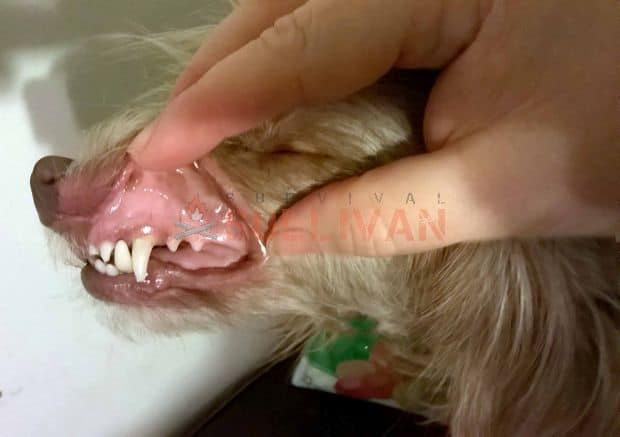


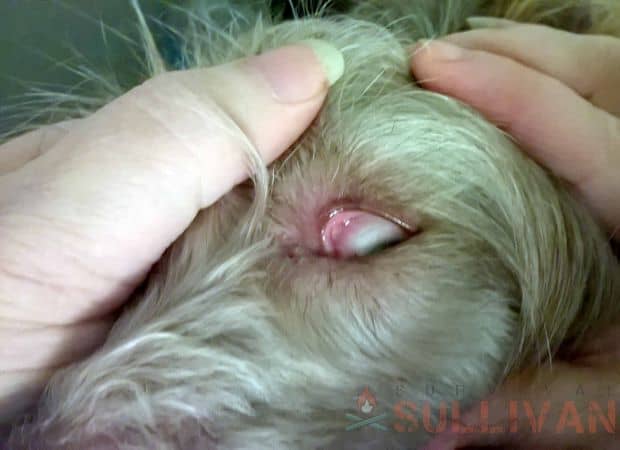
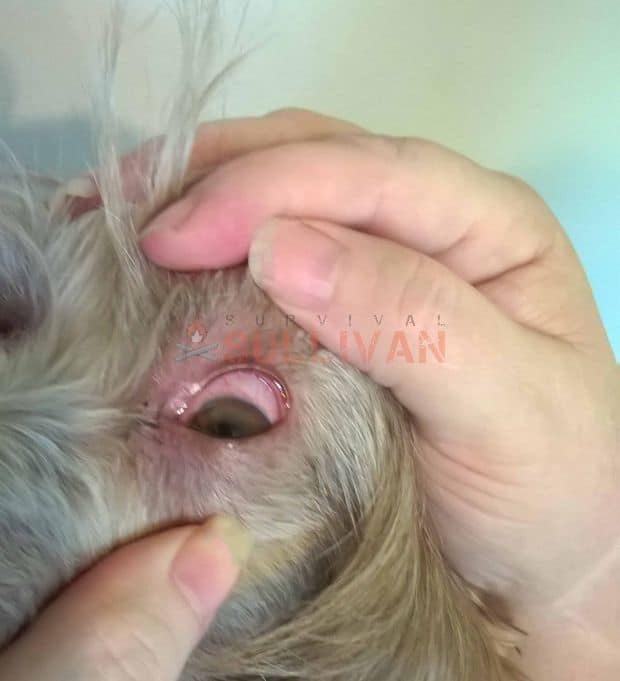
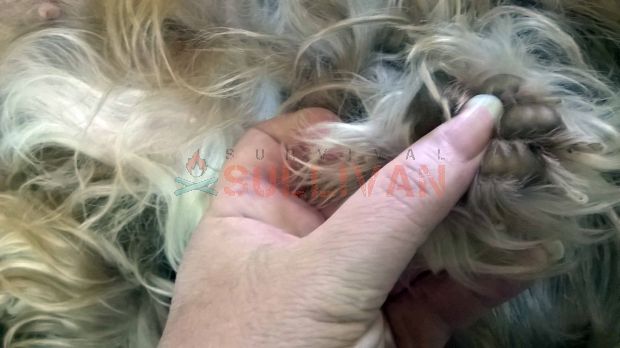
To pull your pet out of shock if they seem to be entering into it, wrap them in a towel or blanket to comfort and warm them:

Use Pediolyte or Gatorade to restore electrolytes and restore brain/systems chemistry with salts/etc.
They need a quick source of calories. We use honey packets and glucose pills as the liver needs glucose immediately. Glucose pills are cheap and with diabetic supplies.
If you know you and your pet will be entering a stressful situation like moving, flying etc, to help prevent shock you will want to carbo-load for 72 hours beforehand.
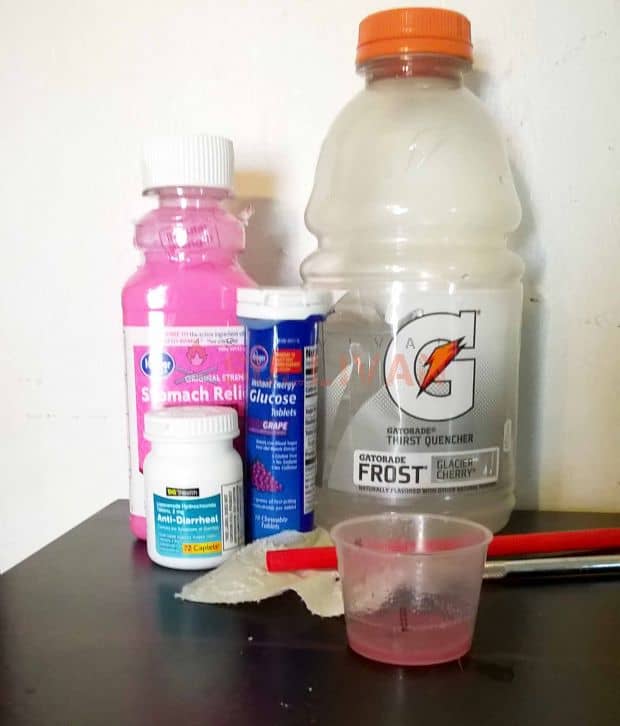
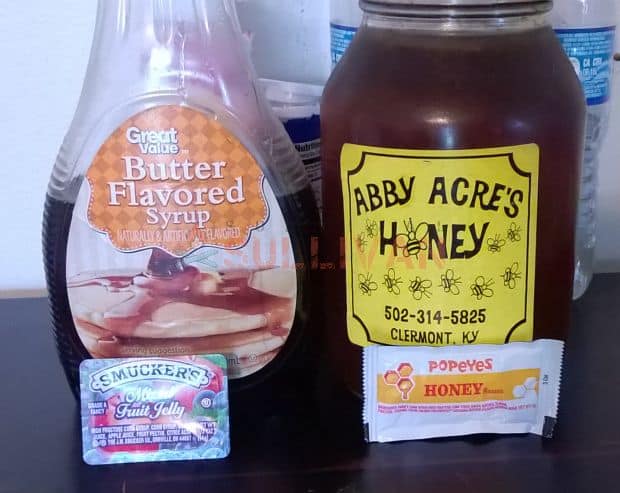
Below, crushing glucose tabs and mixing into a bowl:


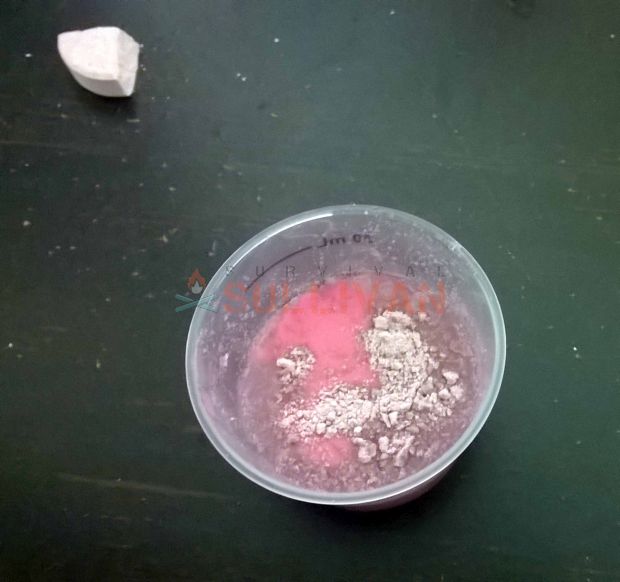
Use a straw to administer with no teeth, and no spill:
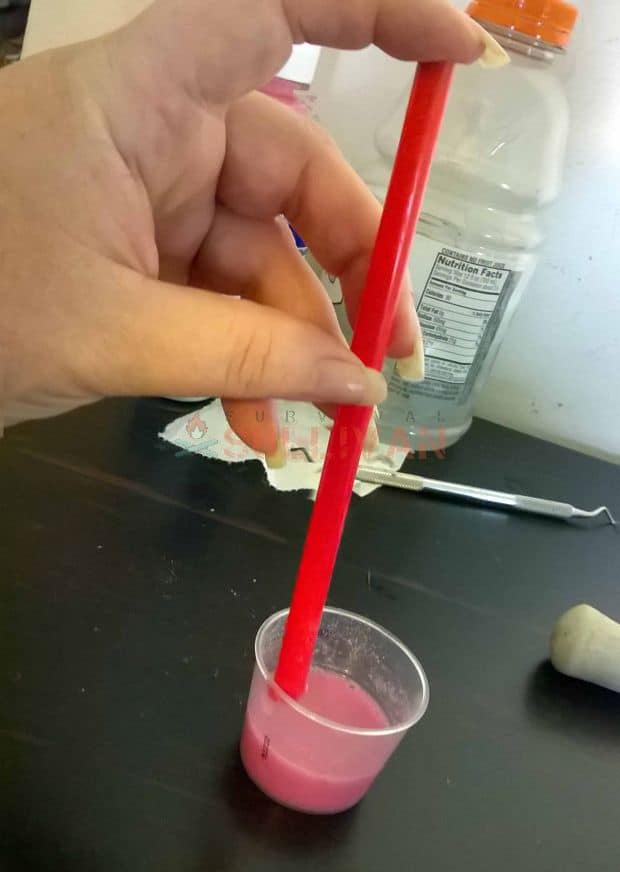
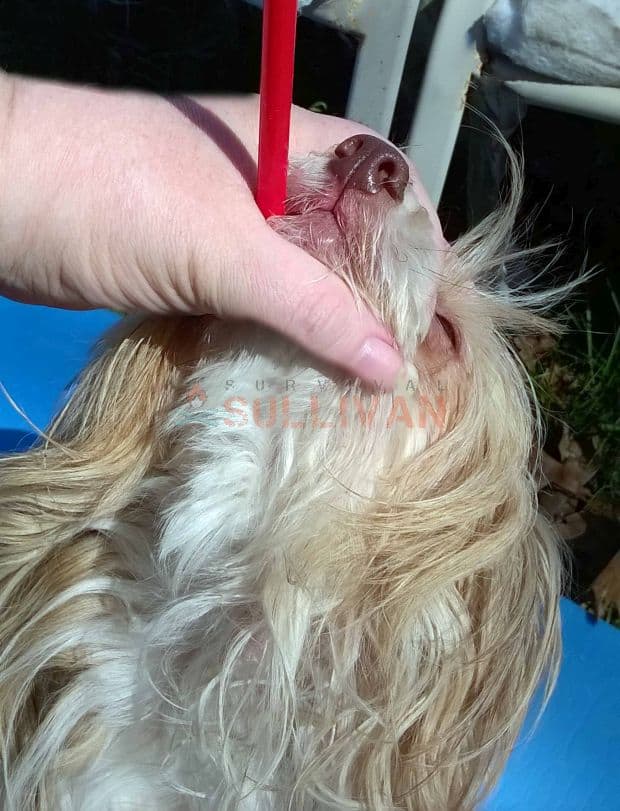
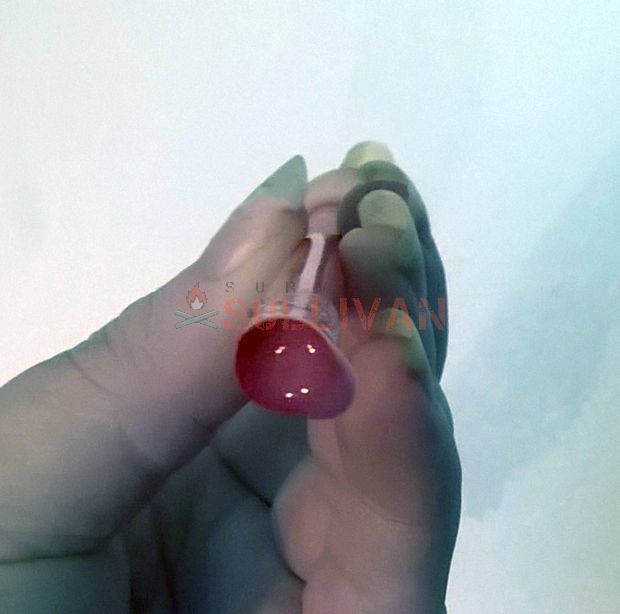
You need to know how to deal with insect stings and how to keep them out of shock from it
For small dogs, bees and hornet stings can be fatal. My silly girl chases them! Insects affect the nervous system in one of two ways. It can be acidic, like bees, so baking soda or something neutral will work on the actual sting. Hornets and wasps are alkaline, and you need to go to the other end of the scale and use lemon juice or vinegar.
When stung, treating them as above for shock, is as much important as getting the stinger out (which can pump venom in there even after it’s broken off!).
You should know how to clear blocked airways for your pet and perform Life Breathing
If you find your pet unconscious and need to help him get breathing gain, check his throat for any blockages by pulling his tongue out and using your finger to gently reach down his throat.
“Life or Rescue Breathing” is breathing air into his mouth, seal off the nose and rest of the mouth as much as you can. Watch for his chest to rise, be gentle you do not want to blow up his lungs, repeat 4-6 times to hopefully restart the pets breathing on his own. Then every 4-5 seconds.
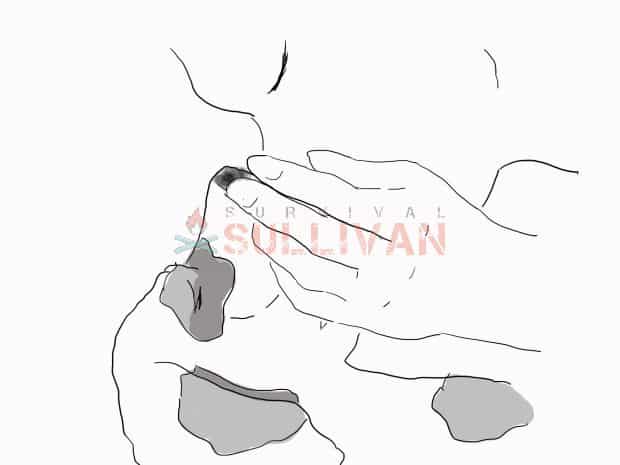
Helping your pet when it is choking
Acute phase: If your pet is wheezing, scratching at his throat and hunching over and seemingly trying to vomit, he could have an object lodged in his throat.
Middle phase: He is panicking, and could bite from fear. He is wide eyed and loosing air and ability to think.
Severe phase: His gums and lips will be turning bluish, his eye rims and ear tips getting will be getting lighter from failing oxygen store in the blood supply, his tongue will begin loosing color.
Check his throat (see below of opening his mouth safely) and mouth for any foreign objects, or signs of a blockage in his throat. You will need to be extremely careful, especially with your fingernails against soft tissue, probe the mouth gently. You do not want to push anything further down if at all possible, OR into the lungs. For my bigger dogs, I can reach all the way to the top of the throat.
BE AWARE- there are 2 openings there, one goes to the throat and down into the stomach, and one into the lungs. On my smaller dogs, I use my pinky, as they try and gulp things when the other comes by so this has happened a few times! I go in at an angle, kind of like a q-tip or when removing a splinter, as you want to prod it up, not force it down fi you find anything. With them sometimes too, its long pieces of hair that is a big issue. They swallow something with hair stuck on it, and you have to remove it without cutting them. Those split ends are now like a steel garrote!
For small breeds, hold them up and hopefully it will dislodge, a few taps may help.
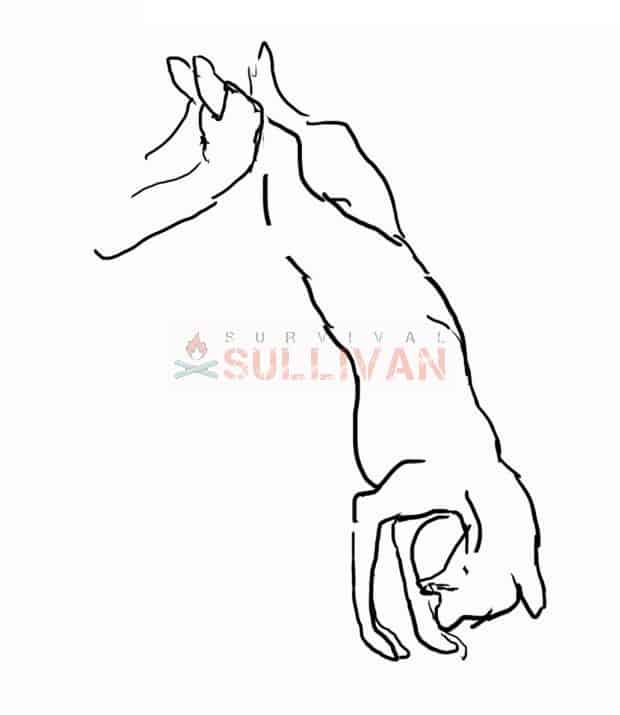
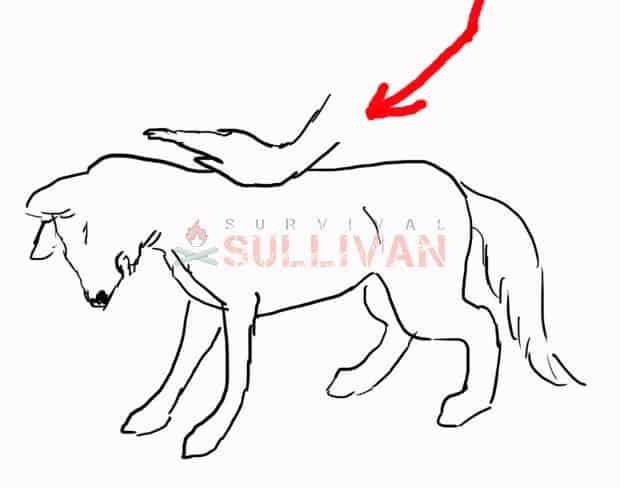
For larger breeds, hold him as you would a person and squeeze to help do the Heimlich maneuver. A few sharp jabs, like you would slap a person on their back, may help first.
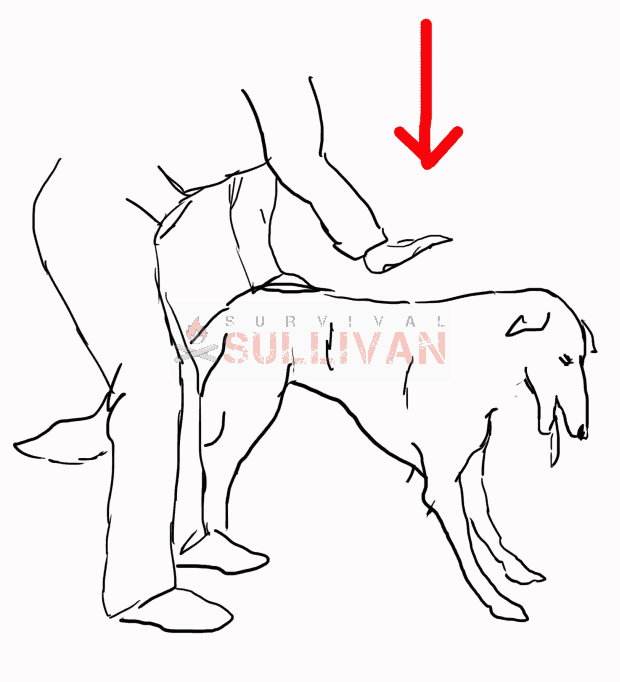
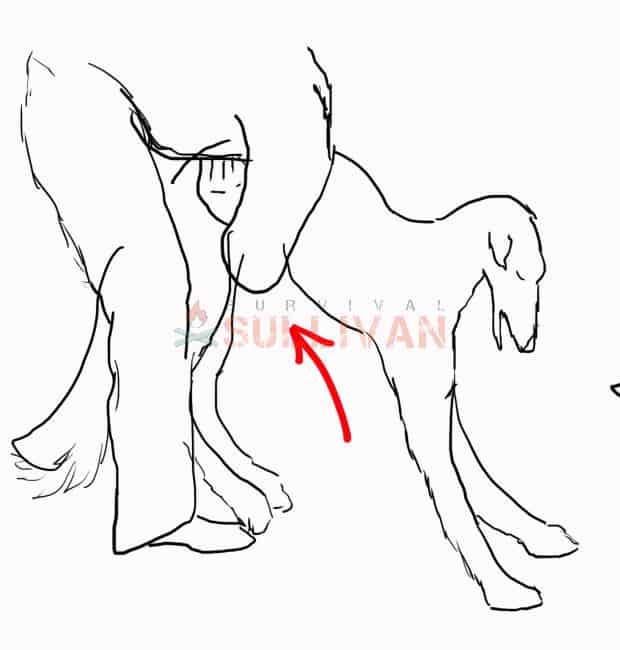
How to help your pet when he has ingested foods or chemicals toxic for him
As dogs love digging in stinky things, like compost, garbage heaps, and other unmentionables they can contract toxic materials pretty easily.
Signs include:
- Nervousness
- Drooling
- Frothing
- Tummy churning
- Shaking and trembling
There are many things he will want and eat, that can be very bad for him and affect him the same as chemical poisoning.
Foods that can give dogs a toxic reaction:
- Alcohol
- Tobacco
- Yeast
- Macadamia nuts
- Real chocolate, the more pure the worse it is- bittersweet is a lot worse than say M&M’s
- Too much salt
- Tea and coffee
- Onions
- Garlic
- Any artificially sweetened candies, chewing gum, or breath fresheners
- Salsa
- Guacamole
- Dairy based products like ice cream, sour cream etc the fillers are awful
Chemicals that are deadly to dogs and cats are antifreeze (its sweet and a few drops are deadly) cleaning products, household poisons for pests, and actually mold and mildew and their cleaning agents.
Deadly chemicals for dogs to steer clear from:
- Tylenol and ibuprofen
- Household cleaners
- Bleach
- Ammonia
- Fertilizers
- Batteries
- insecticides
- Detergents and fabric softeners
- Medications
- Ointments and creams
- Decongestants
- Pain medication
- Carpet deodorizers
- Plants
- Compost
- Stagnant toilet water or ponds
Using activated charcoal can help pull the toxins from his kidneys and flush it out, but it can only do so much. ASPCA Animal Poison Control Center will have the full list of dangerous items.
They report over 200,000 pets died from ingesting human prescriptions in 2016. Call the Pet Poison Helpline (855-213-6680) if you can, if still a time that it may be up.
One of the only things you can do is induce vomiting. A mix of hydrogen peroxide and water can do the trick. One teaspoon per 10 lbs of body weight, 50/50 with water.
Know how to administer CPR on your dog
Know the stags to check your pet and give him CPR is he seems breathless or lifeless. CPR is not required in all circumstances, so you first need to evaluate whether he is breathing if he is collapsed.
EVALUATE: Check to make sure he is breathing by watching for the rise and fall of his chest. Normal breathing is 20-30 breaths per minute, so his dies should move every 2-3 seconds.
If you see no movement, or you feel no air from his nose against your hand, he may need cardiopulmonary resuscitation which combines chest compressions with artificial breath ventilation to jump start the heart basically. So it’s important that this needs to be done as it could be dangerous. If you are to do it, you need to know how to do it correctly. You do not want to do this on a healthy dog,
Step 1 Check for a heartbeat On larger bogs check his heartbeat by laying the dog on his side and lift his front leg up so you can reach into the space over his ribs (this is the 3rd intercostal space by the way- think if you had to do a Pulp Fiction stab into the heart with adrenaline this is where you’d aim).
Again, wait to see if you see any movement, or signs of breathing. Apply pressure first by pressing down to see if you feel any heartbeat. If no heartbeat can be determined, move forward.
Step 2 Check that the dog’s throat and airway is clear (see below for a quick way to open his mouth). Remove any obstructions so you can ventilate. Clear any mucus, spittle, blood, vomit, etc.
Pull his tongue forward and tilt his head to open the airway more. This is the position for artificial respiration.
- For a small dog: use your mouth to cover the nose and mouth. Use your hands to cup the sides to keep it airtight.
- For a large dog: place your mouth over the nose/nostrils, use your hands to keep cheeks flat and keep mouth closed.
Step 3 Administering ventilation: Blow into the dog’s snout until you see the chest wall rise. Then stop. You do not want to damage the dog’s lungs. Move back letting the air escape.
RULE: Do this every 2-3 seconds, aim for 25 a minute.
Step 4 Chest compressions since you are giving the dog air, the heart is not pumping it, so no oxygen is being sent to the brain or organs. So chest compressions are needed for this reason, this is critical as organs will start shutting down.
- For very large breeds you will want to use abdominal compressions or squeezes. The organs such as the liver can be pushed to help assist pressure to the heart, hold the heart with your left hand and use the other to gentle push up and hold with your compressions. Try a few times; if it’s not working then use both for the heart compressions.
- For different breeds you may need a different area to be the most successful per Journal of Veterinary Emergency and Critical Care
For most breeds, this is the normal compression site as described behind the arm.
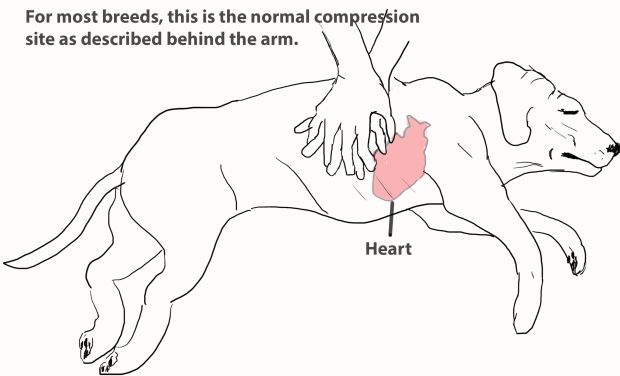
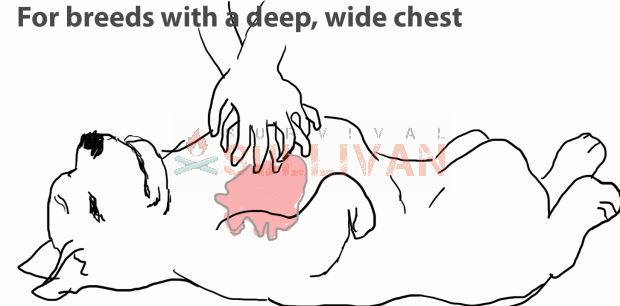
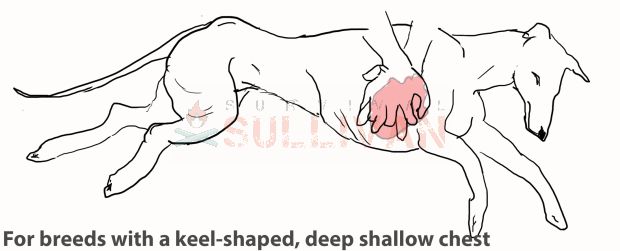
RULE: You want to do 10-12 chest compressions per 1 breath.
Use the area you found above under the leg where the heart is again. Lay your palm one over another then over this area of the heart and press down firmly- gentle enough but with enough pressure to compress the chest 1/3 of the depth. Go to ½ if it seems really deep.
RULE: It is a quick movement, very rapid but gentle push- release, compress release 10-12 times every 5 seconds. Repeat.
Every few minutes stop to see if it’s working and breath has resumed. Hopefully it will, continue until it does. If not within 4-5 minutes, too much damage to the brain and organs will have happened, sadly.
A trick to open an unwilling dog’s mouth
The easiest and fastest way to open a dog’s mouth is to use your fingers to push in the very corners of the mouth and roll them over the back teeth, this makes the dog bite down on his own cheek if he closes his mouth.
Most open right up, and as long as you keep that cheek rolled over the gum, he will not bite down as it hurts. If it slips off, quickly pull your hand away!


How to take your dog’s pulse
Find the indention in the thigh. Push gently, and then rest your fingers to check the pulse.
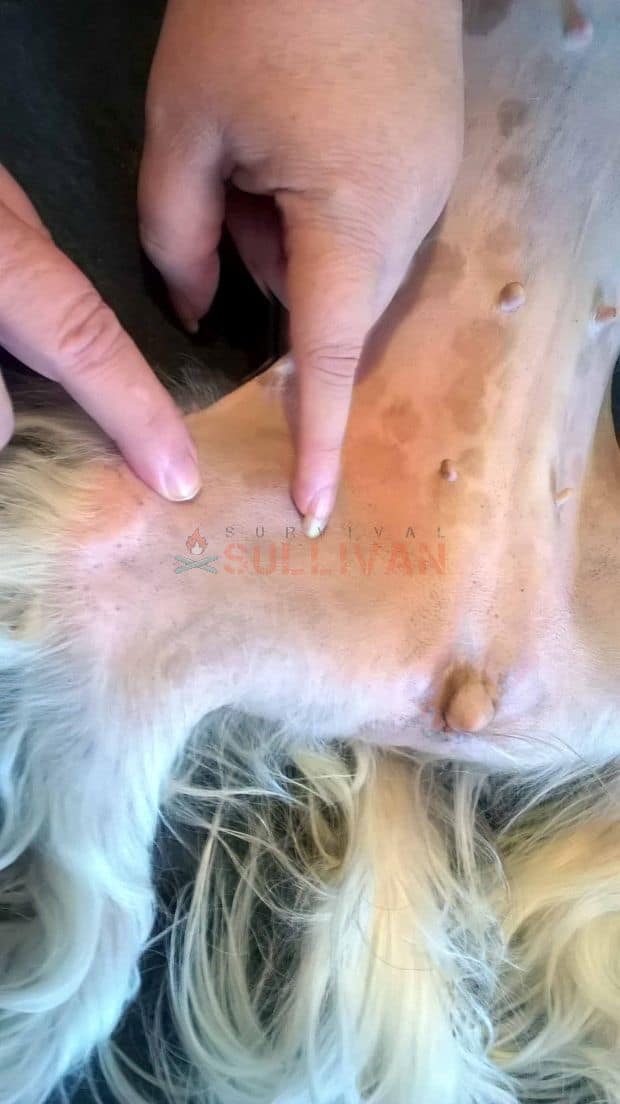
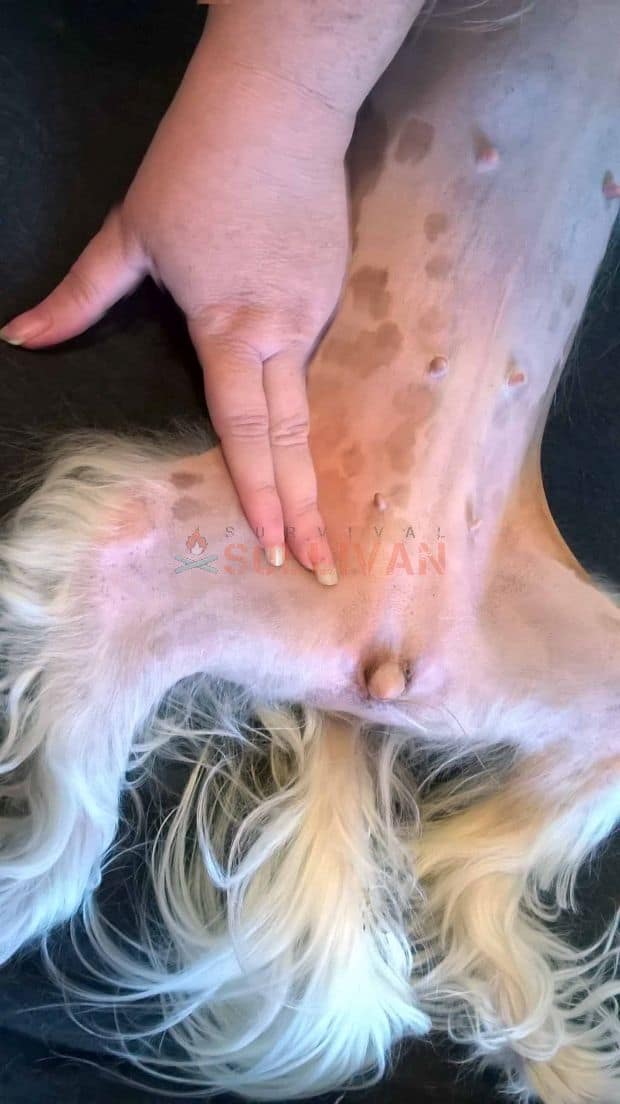
Know the signs of heatstroke and how to cool him down.
If you think your dog may be having a heatstroke, he needs to be treated very quickly. Immediately move him into the shade and place him under a hose with running water or in a tub and fill it with cool water and ice to get his body temperature down. If you cannot do that then soak a towel with cold water and place it around his neck and head, and on his belly to cool him off as much as you can.
NOTE: Do not ice him too much, too quickly or he can go into shock, for smaller dogs use lukewarm to cool water. Once the body is cool, cover your dog with a towel so they don’t continue to lose heat.
Signs of a heat stroke may be:
Initial signs:
- Rapid breathing and panting
- The tongue is bright red
- Inside of the ears is bright red
- Bright red or gums turning purple bluish
- Thick salvia that is sticky
- Weakness
- Dizzy acting
Advanced signs:
- Depressed demeanor and lethargic
- Staggering and confusion
- Vomiting red foamy or red tinged material
- Shock
- Coma
- Death
Treating external wounds on your pet
Dogs, especially younger ones that are curious, can get into all kinds of things. External wounds can be anything from a scrape to a puncture from an animal, or a laceration. Post collapse minor wounds can develop into life threatening concerns, so treat any cuts or small injuries that break the skin very seriously. Proper and prompt cleaning will help prevent infection.
The first thing to do is get clean dressing and apply pressure to stop any bleeding. Flush with water or saline to dislodge debris and small particulates. More.
Burn care for your pet- chemical
After putting on gloves to protect your hands, and a muzzle for the dog, remove all collars, harnesses, clothing etc that may have been contaminated. Be careful not to move the chemical elsewhere, but try to flush the area with cold water for at least 20 minutes. Baking soda, Dawn dish liquid or another mild one, or a mild shampoo can be used.
Use a hose if the burn is in the mouth, or at least a cup to clear the area of the chemical.
Treating temperature burns on your pet
There are a few types of burns that could happen to your dog.
If the skin is still intact, the burn is a first-degree burn. These are usually from a hot liquid or hot object.
For treatment, quickly muzzle and then flush with ice water to stop the heat, then use cold compresses to slow the inflammation for 20 minutes at a time. The quicker you can treat the area, the less the chance of damage.
If the skin is partially or burned all the way through, it is a second- or third-degree burn.
For treatment, be on the watch for signs of shock. This is the first priority. Use a closely woven material or textile to apply a clean dressing to the area. You do not want threads or fivers to get stuck in the affected area. Use T-shirts or old sheets to dress the area further, wrapping it.
How to determine if your pet has a fracture
Usually equated with an injury, a dog can have a break or fracture when you least expect it. It will be painful for your dog, and he will be frightened and anxieties will be high. Remember to remain calm for him, and try not to be to upset or anxious for his sake.
A few things that can cause a fracture:
- A fall
- The breed of dog
- An injury
- Exercise or playing
- Imbalanced diet
- Younger age
- Advanced age
- Bone cancer or disease
This is another condition that needs a veterinarian, the only thing you can try to do is place a splint or cast on the dog, but one that is badly made may do more harm than good.
A splint would immobilize the area and avoid further trauma, or worsening the break. You also want to contain swelling and damage to muscles, blood vessels, and the nerves. For people they just use tape, but here is how to wrap your dog’s toe/metatarsal area.
Wrapping your dog’s toe/foot in sports tape
For a small area like a toe, you can use a temporary wrap that will act as a splint but its made with flexible sports tape.
Step 1 You will need a muzzle, so the dog doesn’t bite, lick or interfere by pulling the wrap. Here is a simple one from the sports wrap itself, you can also use a stocking.
Step 2 You may want to enlist help, and ask for another person to hold the dog. If not secure him.
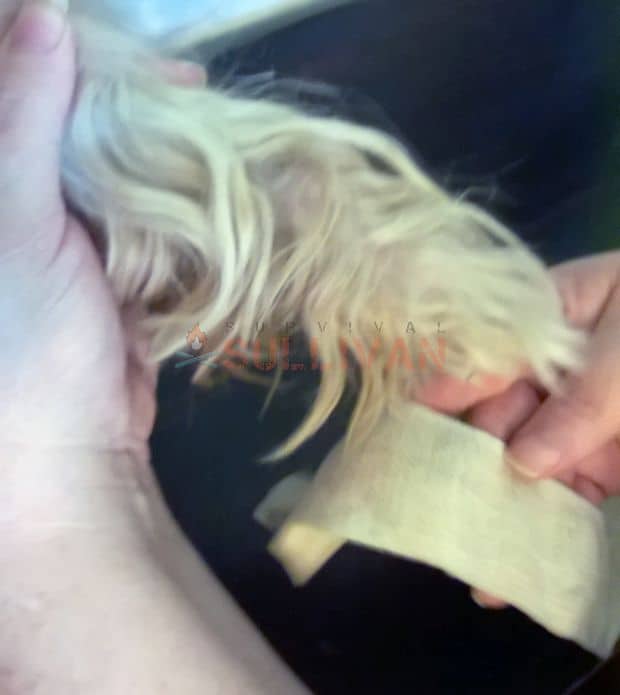
Step 3 Unwind the “hurt free” stretchy wrap. Start over the middle of the area you wish to wrap. The wrap on either side with support and be a splint like encasing.
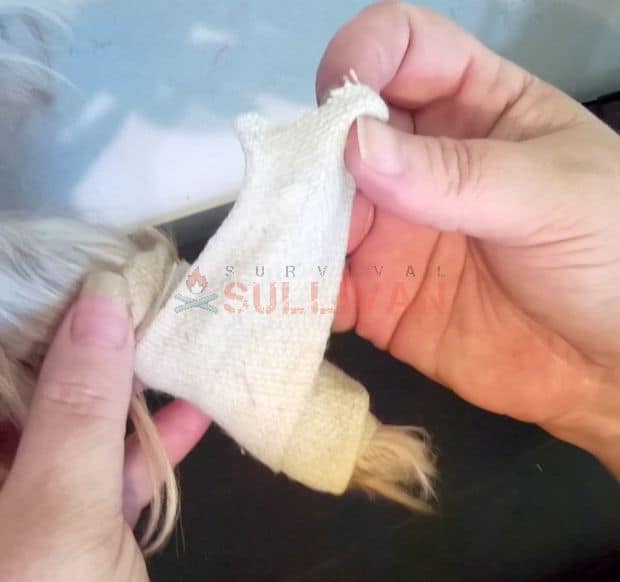
Step 4 they always say the tape will stick to itself and you do not need anything over it. The dog will lick the edges and get it off. So I wrap mine in sports tape, paper tape or an Ace bandage to protect it.

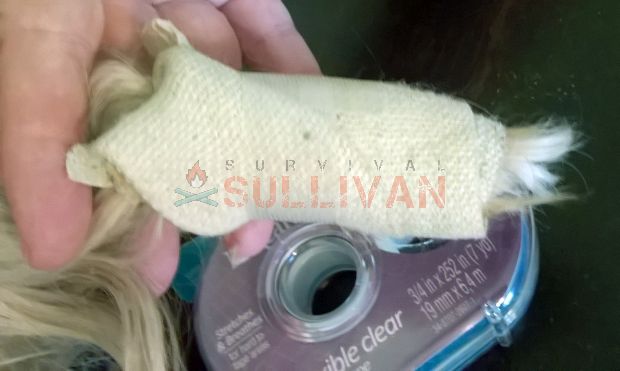
Step 5 (optional) If the dog will not leave it alone, you may need to make him a homemade “cone of shame.” As he may cause more damage or cause the bone to misalign and heal wrong. You can also put things that smell bad on it so he will leave it alone. Perfume, pepper, Vaporub, anything strong and distasteful to stop him from chewing.
Treating internal bleeding and its signs
I am including this section to help you know the signs of internal bleeding and how to make your pet comfortable. Unfortunately, there is not much you can do except get them to a vet immediately they are suffering from internal bleeding.
To help determine the signs look for after a bad fall or if he has been hit by car for example, you will want to know if it is serious and how to prepare for the worst. Some cuts and infections may result in internal bleeding and there are things you can do for those situations that may save the pets life.
The danger of internal bleeding, if it can’t be stopped, is it prevents blood from getting to the organs and the pet goes into shock.
Acute phase:
- Show anxiety and nervousness, fretting
- Shallow breathing
- Very bright, very red gums
- Pulse rate is too easy to find, the throbbing is noticeable
- Very rapid heartbeat
Middle phase:
- Breathing becomes more shallow
- Gums are turning pale and bluish
- Pulse is becoming hard to find
- Pet is weak and lethargic
- Although heart is working harder with an increased heart rate
Severe phase:
- Gums are turning white and mottled
- Weaker pulse but faster heart rate
- Glazed, unfocused eyes
- Heart attack or stroke
- Coma
- Death
Physical examination by feeling the pet’s abdomen may be a sign of internal bleeding, if the abdomen is not the soft and giving normal feeling when you pet it with the flat of your hand.
Gently press the tummy and if it feels tight and drawn, it could mean it’s swollen with blood. The blood fills that space inside the stomach causing it to swell and then it feels hard and is bloated and tight.
There are a few things you can do for the pets comfort, but he needs immediate care from a veterinarian.
How to swaddle your dog to keep him calm
Wrap him in a towel or blanket, swaddle him like a child and lay you dog on his back. Make his head lower than his heart, raise the legs up so oxygenated blood will get to the brain and organs as well as it can in this situation.
Our volunteer, Pinkie Pie. End result at the bottom:



^^ Pinkie Pie laying still and calm as she is swaddled in a soft towel and looks worried as shes wondering what is going on!
This is a life threatening situation, helping the blood get to his organs and brain can help a little, but if it’s not a laceration or infection, you need to mentally prepare and be string for the family.
I am crying as I write this, as I have had to do this and it’s horrible and heartbreaking.If there is a blockage or diversion in the circulatory system by bleeding internally, the brain will not get its needed supply of oxygen to function properly or regulate the body’s organs.
Some say strap the pet to a board to do this, so his body stays straight, but I would just use pillows or towels under him.
Thoughts…
One time quite a while ago, we had a dog that we had placed as a puppy come back to us to live. The ladies new boyfriend didn’t like him as he whined too much he said, and had to be let out several times night and day.
She was deaf, so I guess couldn’t tell. Well, that dog just couldn’t be contained in 6 foot fence or any barriers or cages and finally got out after several attempts and us catching him and bringing him back. He wanted to go home.
Well, after a day of being gone and we looked and drove everywhere, but there are many farms and woods and we couldn’t find him. I go out at dinner time he’s there; I figure he just got hungry.
But when I hugged him his hair was full of blood and wire. Evidently he had got caught in some razor wire, and was too far gone with blood loss. He died on the way to the vet.
After closer examination and some blood tests, the vet told me he cried as he was diabetic and wouldn’t have lasted 4 more days as his kidneys were failing and in the last stages of renal failure and why he needed to be let out all the time.
It’s been a good 14 years+, I am sobbing like a baby as it tears me up still. I know the owner was in a lot of pain in giving him back, and I didn’t ever tell her, as I think it would’ve broken her heart. She never called and asked anyway. He came back for us to help him, but it was too late. He’s buried next to his siblings and parents, so in a tragic way he did come home.
Wrapping it Up
While there are many things you can know to help your pets in emergencies, we hope these common emergencies and their treatments can help you when you may not be able to get to a vet in time, or in a time where there may be no vets to access.
This list was geared towards dogs. Although many of the treatments can be used across the board, we will have following installments describing emergency care for cats, birds, reptiles, and small animal pets in our pet survival series along with making your own pet food stockpiling for pets and related topics.
Thank you for reading and if there is anything you would like to see including in upcoming articles, please let us know!
Disclaimer
The information in this article is provided “as is” and should not be mistaken for or be a substitute for medical advice. The author is NOT a doctor. Always consult your physician before trying any of the advice presented on this page. Seek the help of a professional before attempting any of the advice given in this article. Neither the author, www.SurvivalSullivan.com or the company behind the website shall be held liable for any negative effects of you putting into practice the information in this article.

Growing up in the Bluegrass State, it was a point of familial pride to be able to shoot, trap, identify plants and track animals. Summer camps helped us be well versed in camping, weapons, and survival skills from a young age. We were surrounded by such a lush environment, and we used the resources we had.
I met my soulmate in my happiest place to be- a seemingly enchanted winding trail next to a beautiful wooded glen- where I spent as much time exploring as I could during daylight hours with my trusty four-legged friends.
The bucket list includes living the days painting and writing on a fully self-sufficient homestead, off-grid with our animals and family and plenty of land for the significant other (who I think is a true artist at weapons and living that way) to shoot to his heart’s content. Naturally organic living for us and the animals is a goal.

Excellent information! Thank you for sharing this!
Excellent information! Will be printing this for the big binder! Thank you for sharing this information.
The best of all articles on PET and Survivalism published on the internet. Congratulations!
“…but if it’s not a laceration or infection, you need to mentally prepare and be string for the family. I am crying as I write this…”
Been there enough times myself – it’s never easy. Excellent article…